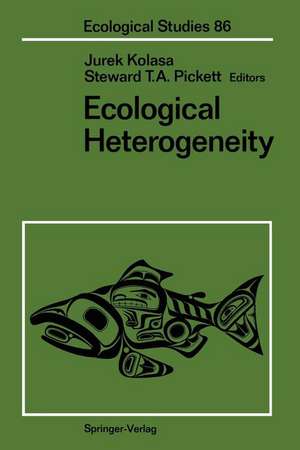Ecological Heterogeneity: Ecological Studies, cartea 86
Editat de Jurek Kolasa Contribuţii de T. F. H. Allen Editat de Steward T. A. Pickett Contribuţii de J.J. Armesto, J P. Barry, S. Brand, H. Caswell, P. Chesson, J E Cohen, R.K. Colwell, P.K. Dayton, J.A. Downing, R.H. Gardner, T.W. Hoekstra, B. Jackson, P.A. Keddy, C. Loehle, M.J. McDonnell, R. P. McIntosh, B.T. Milne, S. Naeem, R.V. O'Neill, C.D. Rollo, M. Shachak, M.G. Turneren Limba Engleză Paperback – 5 oct 2011
Din seria Ecological Studies
- 18%
 Preț: 1118.93 lei
Preț: 1118.93 lei -
 Preț: 553.71 lei
Preț: 553.71 lei - 18%
 Preț: 1680.55 lei
Preț: 1680.55 lei - 18%
 Preț: 1003.38 lei
Preț: 1003.38 lei - 20%
 Preț: 1004.69 lei
Preț: 1004.69 lei -
 Preț: 480.62 lei
Preț: 480.62 lei - 5%
 Preț: 752.26 lei
Preț: 752.26 lei - 15%
 Preț: 643.99 lei
Preț: 643.99 lei - 15%
 Preț: 644.18 lei
Preț: 644.18 lei - 15%
 Preț: 652.49 lei
Preț: 652.49 lei - 18%
 Preț: 789.83 lei
Preț: 789.83 lei -
 Preț: 382.36 lei
Preț: 382.36 lei - 15%
 Preț: 643.48 lei
Preț: 643.48 lei - 15%
 Preț: 646.30 lei
Preț: 646.30 lei - 15%
 Preț: 634.32 lei
Preț: 634.32 lei -
 Preț: 384.86 lei
Preț: 384.86 lei - 18%
 Preț: 789.98 lei
Preț: 789.98 lei - 15%
 Preț: 645.14 lei
Preț: 645.14 lei - 15%
 Preț: 649.39 lei
Preț: 649.39 lei - 18%
 Preț: 1005.43 lei
Preț: 1005.43 lei - 18%
 Preț: 949.23 lei
Preț: 949.23 lei - 15%
 Preț: 649.54 lei
Preț: 649.54 lei - 15%
 Preț: 643.34 lei
Preț: 643.34 lei - 15%
 Preț: 649.71 lei
Preț: 649.71 lei - 15%
 Preț: 638.76 lei
Preț: 638.76 lei - 18%
 Preț: 957.62 lei
Preț: 957.62 lei - 18%
 Preț: 1235.25 lei
Preț: 1235.25 lei - 18%
 Preț: 962.18 lei
Preț: 962.18 lei - 18%
 Preț: 949.23 lei
Preț: 949.23 lei - 15%
 Preț: 660.68 lei
Preț: 660.68 lei -
 Preț: 397.76 lei
Preț: 397.76 lei - 15%
 Preț: 638.24 lei
Preț: 638.24 lei - 18%
 Preț: 942.31 lei
Preț: 942.31 lei - 18%
 Preț: 1232.57 lei
Preț: 1232.57 lei - 15%
 Preț: 651.34 lei
Preț: 651.34 lei - 18%
 Preț: 952.72 lei
Preț: 952.72 lei - 18%
 Preț: 1834.27 lei
Preț: 1834.27 lei - 18%
 Preț: 1229.10 lei
Preț: 1229.10 lei -
 Preț: 423.95 lei
Preț: 423.95 lei - 18%
 Preț: 948.92 lei
Preț: 948.92 lei
Preț: 642.83 lei
Preț vechi: 756.27 lei
-15% Nou
Puncte Express: 964
Preț estimativ în valută:
123.00€ • 128.77$ • 101.78£
123.00€ • 128.77$ • 101.78£
Carte tipărită la comandă
Livrare economică 05-19 aprilie
Preluare comenzi: 021 569.72.76
Specificații
ISBN-13: 9781461277811
ISBN-10: 1461277817
Pagini: 348
Ilustrații: XI, 332 p.
Dimensiuni: 155 x 235 x 18 mm
Greutate: 0.49 kg
Ediția:Softcover reprint of the original 1st ed. 1991
Editura: Springer
Colecția Springer
Seria Ecological Studies
Locul publicării:New York, NY, United States
ISBN-10: 1461277817
Pagini: 348
Ilustrații: XI, 332 p.
Dimensiuni: 155 x 235 x 18 mm
Greutate: 0.49 kg
Ediția:Softcover reprint of the original 1st ed. 1991
Editura: Springer
Colecția Springer
Seria Ecological Studies
Locul publicării:New York, NY, United States
Public țintă
ResearchCuprins
1. Introduction: The Heterogeneity of Heterogeneity: A Glossary.- 2. Concept and Terminology of Homogeneity and Heterogeneity in Ecology.- 3. Role of Heterogeneity in Scaling of Ecological Systems Under Analysis.- 4. Heterogeneity as a Multiscale Characteristic of Landscapes.- 5. Heterogeneity and Spatial Hierarchies.- 6. Communities in Patchy Environments: A Model of Disturbance, Competition, and Heterogeneity.- 7. Stochastic Population Models.- 8. Managing and Monitoring Ecosystems in the Face of Heterogeneity.- 9. Biological Heterogeneity in Aquatic Ecosystems.- 10. Working with Heterogeneity: An Operator’s Guide to Environmental Gradients.- 11. Relations Among Spatiotemporal Heterogeneity, Population Abundance, and Variability in a Desert.- 12. Ecological Consequences of Heterogeneity of Consumable Resources.- 13. Spatial Heterogeneity During Succession: A Cyclic Model of Invasion and Exclusion.- 14. Physical Heterogeneity and the Organization of Marine Communities.
















